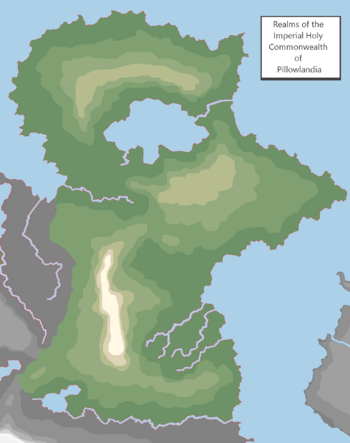Crown Kingdoms
Crown Kingdoms of Cenaesia Ríochtaí na Córoine | |
|---|---|
| Motto: For the Greater Good | |
| Anthem: Lugh Save Cenaesia | |
 Territory of the Crownlands within continental Cenaesia, oversees territories not shown. | |
| Capital | Tír Tairngir |
| Largest | Moscou |
| Official languages | Cenaesian |
| Recognised national languages | Midlandese, Rhenish |
| Demonym(s) | Cenaesian, Crownlander |
| Government | Parliamentary Absolute Monarchy |
• Ard Rí | Cathal XIV MacLugh Varigee |
| Formation | |
• Kingdoms of Cenaesia | October, 142 BE |
• Cenaesian Empire | January 1, 0 CE |
• Crown Kingdoms of Cenaesia | September 12, 1934 |
| Population | |
• 2068 estimate | 5,297,123,230 (4) |
• 2060 census | 5,238,782,291 |
| Yes | |
| Date format | dd-mm-yyyy |
| Driving side | right |
The Crown Kingdoms of Cenaesia (Cenaesian: Ríochtaí na Córoine), also known informally as the Crownlands, is an absolute monarchy located on the northeastern section of the continent Cenaesia. It shares a land border to its southwest with the Midlands Republic and the White Kingdom to its south. It additionally neighbors the Highlander Federation across the Meridian Bay. The nation contains an inland freshwater sea, known as the Sea of Lugh along with several other large navigatable rivers and waterways. Extensive coastline results in maritime borders with the North Cenaesian Ocean to the north and the Harib Sea to the east. The Crown Kingdoms Themselves have a total land area of [insert absurdly large number here] square kilometers and a population of 5.2 billion people as of 2067. The capital is Tír Tairngir, located in the southeast of the nation.
Etymology
The nations current name derives from the original declaration of land rights made by the Varigee dynasty upon the conquest of central Cenaesia known today as the Midlands Republic subsequent to the conquest of large swaths of southern Cenaesia. In order to effectively manage the newly conquered lands, several large regions were defined as the largest of the newly formed imperial bureaucracy. Among the three administrative divisions created was the Ríochtaí na Córoine, literally meaning the Kingdoms of the Crown. These Kingdoms were directly controlled by the Cenaesian Crown in a personal union, and therefore more directly managed by ruling monarch of the newly formed Empire. As a result of the Ard Rí possessing the kingship or crown of each kingdom the administrative name for the land picked up use among commoners and aristocrats alike.
The name was further reinforced when the Crown Army of Moscou defected from the rebel forces led by the former royal family in the Cenaeisan Revolt of 921 and sided with the Ard Rí at the time Tomás Varigee II, with the phrase "eight unto one" being taken up as a battle cry during the Siege of Moscou. However, this claimed battle cry is widely disputed by academics and does not have official recognition from the Imperial Academy of History nor the Church of Cenaesia.
History
Following this edict, the newly crowned Ard Rí of Cenaesia stripped the various royal families of the eight kingdoms of their crowns. They were given an alternative title of Arch Duke, held by the senior member of the house, which completed their transformation and assimilation into the newly constructed continent-wide aristocratic class. Additionally, instead of abolishing the crown of each kingdom located inside the modern Crown Kingdoms the Emperor added the titles added to his own.
The assumption of the crowns of each realm was followed by land reforms that resulted in a large quantity of land across the Cenaesian Empire being transferred to the possession of the Ard Rí and the whole of House Varigee.

